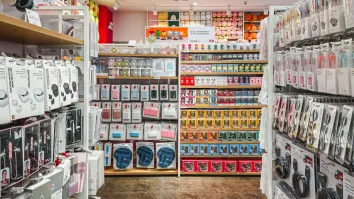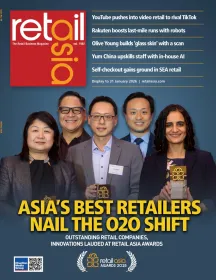
This 11.11, the real battle lies in shopper confidence – not the biggest discount
By Martin MachinandiarenaFor brands and marketers, this generation is the new battleground for earning checkout confidence.
As November rolls around, digital platforms and physical stores around Asia-Pacific (APAC) gear up for the annual rush of Singles’ Day, also known as 11.11. It has become one of the region's biggest retail moments in the calendar year.
What started as a Chinese phenomenon has now grown into a pan-Asian celebration, as millions of shoppers hunt for lightning deals, exclusive launches, and once-a-year bargains.
However, as competition intensifies and the market matures, it’s high time for brands and merchants alike to tackle one of the biggest challenges: cart abandonment. Even during peak shopping festivals, when excitement and discounts run high, brands and retailers struggle with shoppers dropping off at checkout.
In APAC, cart abandonment stands at an overwhelming 80.3%, notably higher than EMEA (78.38%) and the Americas (72.5%). For marketers in digital-first markets such as Singapore, this remains one of e-commerce’s thorniest problems.
Why do shoppers bail? At its core, cart abandonment points to a deeper challenge: a lack of shopper confidence. Faced with overwhelming options in a marketplace saturated with choices, consumers hesitate– second-guessing the price, the product, and ultimately, the purchase itself.
Nowhere is this behaviour more visible than amongst Gen Z shoppers, a digitally native cohort shaped by constant stimulation and easy access to options. As they grow to represent a quarter of the region’s population by 2025, their rising purchasing power and expectations are redefining how brands must address cart abandonment.
For brands and marketers, this generation is the new battleground for earning checkout confidence.
The real culprit: Decision overload and consumer confidence
The issue of cart abandonment amongst the Gen Z shopper goes beyond technical glitches at checkout, it’s a symptom of decision overload. Having grown up in a digital-first environment, constant connectivity, and limitless choice have made this generation more informed than ever, yet also more indecisive due to a constant barrage of options.
Nearly half of Gen Z shoppers say it has become harder to make decisions compared to a year ago. This surge in options leads to decision paralysis, where shoppers hesitate because they are unsure if they have found the best fit.
For many, the problem starts well before checkout; it begins at product discovery and evaluation, where too many options and too little guidance can erode confidence. Building that confidence early, through clear, relevant curation, has become essential.
A study conducted by The Decision Lab and Morning Consult found that more than seven in ten Gen Z shoppers struggle to strike the right balance between having enough options and feeling overwhelmed.
Laying the groundwork: Building confidence through curation
This is where curation steps in. More than just a buzzword, curation is the art and science of organising options to ease decision overload and build shopper confidence.
When faced with hundreds of similar options, consumers value guidance in narrowing down their decisions, clearing pathways to help them feel secure in their decisions.
In APAC, this need for relevance is even more pronounced due to the significant influence of Gen Z consumers. This digitally native generation’s shopping behaviours are reshaping the markets, with them expecting brands to not only simplify search but also reflect their individuality and values.
Recent studies show that nearly two-thirds of shoppers prefer personalised shopping recommendations, with 75% of shoppers saying the ability to refine options leads to more confident purchases. In fact, 60% of shoppers believe that curation helps ease FOBO (fear of better options), a figure that climbs higher amongst Gen Z at 68%.
For brands, this means that curation must go beyond generic recommendations to deliver personalised and intuitive experiences tailored to this demographic.
When done well, curation goes beyond reducing friction, it builds consumer trust and drives deeper engagement. According to a recent Decisions report, 90% of users surveyed have found that curation enables them to find products relevant to them, building consumer confidence and inspiration to purchase.
Yet, despite the importance of personal relevance in today’s shopping experience, many businesses across APAC have yet to fully operationalise strategies for confident curation. This gap between consumer expectations and brand execution is precisely where the next opportunity lies.
From curation to confidence
Fixing cart abandonment is not only a technology problem; it is a trust problem. Shoppers abandon carts when they are unsure about fit, value, or fulfilment, so the simplest wins are the ones that reduce doubt early.
Brands can translate this into simple, measurable actions by focusing on five key strategies to engage shoppers at multiple stages of their buying journey.
First, begin by uploading and optimising your product catalogue to ensure your items are easily discoverable across search and browsing experiences. Second, create curated, image-first creative content that highlights complete looks rather than single items, helping shoppers visualise your brand’s offerings in lifestyle contexts.
Third, leverage advanced ad tools designed to optimise performance and drive results, enabling campaigns to reach the right customers at the right time. Fourth, adopt a full-funnel media strategy to help shape shopper decisions continuously, amplifying impact beyond single touchpoints. For example, brands can remove last-mile doubt by making delivery windows, costs and payment options explicit on each product listing.
Finally, establish reliable measurement systems that track both short-and-long-term outcomes to understand a campaign’s effect and help guide ongoing optimisation. When discovery is visual and curation is deliberate, shoppers gain clarity earlier and are far more likely to complete a purchase.
Measuring performance holistically, across short and long-term metrics, enables marketers to see how confidence grows and drives purchase. This insight lets brands align strategy with intent, creating a more personalised shopping experience.
In APAC, tackling cart abandonment goes beyond fixing checkout pain points. It means addressing the confidence crisis shaping today’s shopper journey.
By embracing curation, leveraging visual search, and adopting full-funnel strategies powered by artificial intelligence and automation, marketers can meet consumers where they are.
The brands that succeed will be the ones that harness the power of curation, build trust, and inspire confident action.




















 Advertise
Advertise








